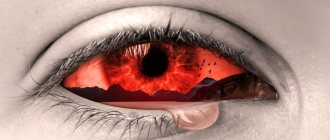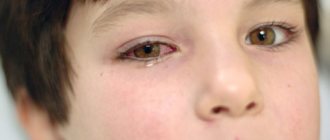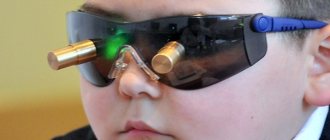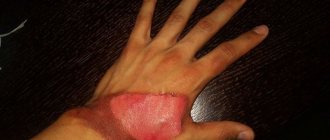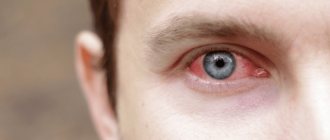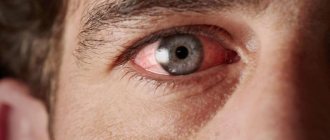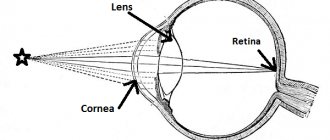After all these manipulations, you should cover the affected area with a clean bandage, give the patient a sedative and send him to the hospital, where appropriate treatment will be carried out.
It depends on the severity of damage to the eyeball and the presence of concomitant conditions (inflammation, pain shock and others).
Further therapy
Medical centers offer these procedures to treat eyes damaged by chemicals. First of all, medications are used. Among them:
- local anesthesia for the purpose of carrying out manipulations to remove aggressive substances (Lidocaine);
antitetanus serum;
antibiotics to prevent infection (drops containing ciprofloxacin, Levomycetin eye ointment);
Additionally, citrates (citric acid salts) or ascorbic acid are prescribed, which improve calcium metabolism in the affected area.
If extensive damage to the eyeball is observed (with burns of 3 or 4 degrees of severity, when defective conditions occur), then surgical intervention may be required:
- tarsography (suturing the skin of the eyelids during healing);
- tissue transplantation;
- autotransplantation;
- keratoplasty (to remove scars);
- prompt correction of the consequences of burns (glaucoma, cataracts).
In some conditions (subatrophy - slow death of the damaged eye), keratoprosthesis may be required - replacing the cloudy cornea with an artificial optical device.
Eye burns of chemical origin are common. Most often they are caused by acids and alkalis that enter the eye due to carelessness or failure to follow safety rules when in contact with aggressive chemicals. Such burns should be treated by a qualified physician.
Ammonia got into my eye, what should I do?
Eye burns are not uncommon. They may be different. But the most dangerous type is a chemical burn to the eye. What is it, what causes it, how can I help a person with burns of varying severity? Let's try to answer these questions.
Main characteristics of injury
A chemical burn is an injury to the eye caused by exposure to aggressive chemicals.
First of all, there is damage to the conjunctiva - a thin connective membrane that covers the outer surface of the eye and the back surface of the eyelid.
It performs an important function because it releases a special liquid that lubricates the eye and prevents it from drying out. Its damage often leads to impairment and even loss of vision.
Damaging substances
Chemical burns of the conjunctiva are not uncommon these days. According to statistics, 10% of all eye burns are of chemical origin. Most often, damage occurs when aggressive substances come into contact with the ocular surface. Among them are:
Acids. Most often, burns occur with the following acids:
- hydrochloric acid (HCl);
- sulfuric (H2SO4);
- acetic (HC, COOH);
- hydrofluoric(HF).
An acid burn is similar to a thermal burn. It affects the conjunctiva and cornea without spreading into the eyeball. The degree of damage is influenced by the concentration of acids and the duration of their exposure.
At the site of acid entry, a necrotic area appears, which is separated from healthy tissue (coagulation). In this case, a very strong pain syndrome appears, since the optic nerves are irritated.
Alkali. The most common alkalis that cause burns are:
- ammonia (ammonium hydroxide);
- caustic soda (sodium hydroxide);
- magnesium hydroxide;
- potassium hydroxide;
- slaked lime (calcium hydroxide).
Burns from alkaline substances are considered more dangerous because the damage extends deep into the eye, from where it is not easy to remove. At the same time, the time of negative impact increases.
This occurs due to the fact that alkali provokes liquefaction necrosis in the proteins, which leads to their melting (myomalacia) and spreading throughout the eye. In this case, the optic nerves are damaged by alkali, which leads to their loss of sensitivity. That is why a person with alkaline burns practically does not feel pain. This often leads to underestimation of damage.
Risk factors
How do chemical eye burns occur? This occurs through direct contact with acids or alkalis, when, due to carelessness or failure to comply with safety measures, these aggressive substances first enter the area of the conjunctiva of the eye, causing its necrosis (death). Among the risk factors contributing to the occurrence of such burns are:
- Construction or repair manipulations. These types of work often use chemicals that can cause burns.
- Using aggressive substances in everyday life without following safety rules.
For example, improper or careless use of ammonia, household chemicals containing dangerous acids or alkalis. It is also risky to leave such substances within the reach of children. - Work involving frequent use of chemicals. This may be the production of concentrated acids and alkalis or other types of work where such substances are used.
- Careless behavior with car batteries that contain sulfuric acid concentrate.
This is especially true for car enthusiasts who do not have professional skills in working with cars. - Alcohol abuse. In this state, very often people do not follow safety rules, which leads to unpleasant consequences.
Any type of burn is potentially dangerous.
Therefore, first of all, a person needs emergency care for a chemical burn to the eyes.
The sooner it is provided, the more favorable the forecasts will be.
How does it manifest?
The severity of a chemical burn depends on many factors. Among them are:
- type of chemical (acid, alkali, etc.);
- the amount of substance that has reached the surface of the eyes;
- concentration of the chemical (the more diluted it is, the less harm the burn will cause);
- temperature of the substance (the higher it is, the more complex the consequences);
- duration of exposure to the eyes.
The favorable outcome of treatment is also influenced by the patient’s age (the younger the person, the faster the recovery), as well as how timely and high-quality first aid was provided.
There are several degrees of eye damage from chemicals, which differ in the severity of the damage and are manifested by specific symptoms. There are 4 degrees of chemical burns:
Source: https://medicskin.ru/v-glaz-popal-nashatyrnyj-spirt-chto-delat.html
What consequences might there be?
Alcohol burns to the eye are classified in several areas of damage: eyelid skin, cornea, conjunctiva, eyeball, adnexa.
There are four stages of burn :
- Initial stage . It lasts for one or two days. During this period, the patient feels acute discomfort in the eye and suffers from tearing. It is at this stage that tissue death occurs.
- Second stage. Duration from two days to several weeks (depending on the individual characteristics of the body). The cornea swells, severe trophic disorders occur, which can cause irreparable damage to vision.
- Third stage. Takes another 4 – 16 weeks. Hypoxia begins. Due to insufficient oxygen supply to the tissues of the eyeball, trophic processes begin, and the vessels of the cornea grow.
- Fourth, final stage. It may take several years. The mucous membranes become scarred due to excessive production of collagen by the body.
Stay up to date! For vision and health, this is fraught with the following consequences:
- Decreased visual acuity. Initially, this may be due to epithelial damage, swelling or cloudiness caused by lacrimation. It is worth considering that vision may not deteriorate immediately - some consequences of burns become apparent only after a while. Most often, myopia caused by an injury of this kind is irreversible.
- Increased intraocular pressure. Caused by deformation and shortening of collagen in the trabecular apparatus. In the future, it can provoke inflammatory processes in the anterior part of the eye.
- Inflammation of the conjunctiva . This disease is possible even with a mild alcohol burn. It causes severe discomfort and makes the eyes more sensitive to light.
- Corneal perforation . A rather rare phenomenon that occurs only in severe chemical burns, when the ability for natural tissue regeneration is significantly reduced.
- Scarring of the eyelid/conjunctival surface. Leads to serious problems, complications and inflammation, especially if the scar prevents the proper closure of the palpebral fissure (closure of the eyelids).
Ammonia got into the eye, what should I do?
Good day to you, dear readers! A burn with ammonia is one of the most common household burns. It occurs due to careless and improper use of this drug.
Ammonia is a clear, colorless solution with a strong, unpleasant aroma. In medicine, it is used as a local wound healing agent.
In addition, it is used as a respiratory stimulant during loss of consciousness, an antiseptic, and also as a disinfectant and stain remover for household needs.
Causes of injuries caused by ammonia solution
The most common cause of burns is contact of undiluted ammonia with the epidermis and mucous membranes. Some adherents of alternative medicine try to use this drug orally, after which they experience damage to the esophagus and stomach.
Remember that ammonia is an extremely toxic and strictly local solution (can only be used externally).
Ammonia contains caustic alkaline substances and alcohol. Alcohol corrodes the skin, and alkalis have a strong cauterizing effect.
Chemical injuries are dangerous because the harmful substance penetrates deeply into the skin, begins to affect it faster and is difficult to remove from it.
The victim of the above-described alcohol solution must be provided with first emergency aid in a timely manner. How to do this is described below in the article.
And now I propose to study the main symptoms of ammonia burn.
Signs of ammonia burns
At the site of contact of the solution with the skin or mucous membranes of the oral cavity, persistent superficial hyperemia first appears, accompanied by multiple ulcerations. Affected area:
- itches a lot;
- swelling;
- hurts;
- becomes covered with sores or blisters;
- blushes.
If assistance is not provided to the victim at this stage, then after 12-24 hours he may develop severe lesions of the skin and mucous membranes, accompanied by tissue necrosis. Necrosis is the death of tissue after which it cannot be restored.
Alkaline (ammonia) burns of the mouth and eyes are especially dangerous. If a dangerous drug enters the esophagus, a severe burn of the mucous membrane occurs, the spread and progression of which is difficult to stop.
Even the weakest 10% preparation mercilessly absorbs moisture and rapidly dissolves protein, forming alkaline albuminates with it. Penetrating into the bloodstream, these substances begin to poison the body literally.
Consequences of eye injury from ammonia
Vision is the most valuable thing that nature has given us. It must be protected, especially from alkaline burn injuries.
When concentrated ammonia gets on the skin of the eyelids, blisters and partial necrosis of the dermis occur. If the conjunctiva is affected, it becomes: pale, matte, rough, uneven.
In addition, signs of more serious damage may appear: swelling, hemorrhage, anaphylactic shock.
Complications may be as follows:
- iridocyclide;
- cataract;
- corneal necrosis;
- prolapse of the iris.
If ammonia gets into your eyes, rinse them immediately with cool running water. At the same time, it is necessary to call an ambulance, since only a doctor can predict and prevent the consequences of alkaline injuries.
Emergency care for a burn with ammonia
It is recommended to provide emergency assistance immediately after contact with an alkaline substance. If the substance gets on the skin, remove any clothing that may have gotten wet and rinse the wound with plenty of running water.
After rinsing, the pain should decrease slightly. This means that the ammonia has stopped corroding the tissue and the injury has stopped spreading.
The second stage of emergency assistance is aimed at completely neutralizing the harmful substance.
To do this, apply a gauze bandage soaked in a weak solution of acetic or citric acid to the skin or mucous membranes (lips, tongue, but not eyes). Why acids? It's simple: the acid neutralizes the alkali.
Alkaline burns cause severe pain, so the victim cannot do without painkillers. For pain relief you can take:
If the burn is extensive and deep, then doctors may prescribe narcotic analgesics for pain. Read more about analgesics that are used for burns in a separate article on this website.
Absolutely all chemical burns must be treated under the supervision of a specialist doctor. The specialist will determine how to treat the injury in the future. For example, eye burns are treated with anti-inflammatory camels, and skin injuries are treated with wound healing and anti-scar ointments.
Preventing burns with ammonia
- Work with the drug carefully, protect your hands with gloves. Medical rubber gloves are quite suitable for these purposes, but it is better to use denser, better quality and more reliable ones.
- Do not trust folk recipes that recommend taking ammonia orally. Even in diluted form, this drug is not suitable for oral use.
- If you use ammonia to remove stains, thoroughly ventilate the room during and after cleaning. Use diluted ammonia.
- Keep the alcohol solution out of the reach of children. The bottle of alcohol must always be tightly closed, otherwise its contents may accidentally spill onto someone in the household.
- Do not wipe your skin with undiluted ammonia.
Source: https://womaninred.ru/nashatyr-popal-v-glaz-chto-delat/
Precautionary measures
To prevent chemical burns, you should:
- use personal protective equipment - rubber gloves, safety glasses, respirator;
- store ammonia in a glass container with an airtight lid;
- thoroughly ventilate the room after using the drug;
- refrain from wiping the skin and mucous membranes with the drug.
It is strictly not recommended to use ammonia for rinsing your mouth. When treating skin diseases, it is better to give preference to safer antiseptics - Chlorhexidine, Miramistin.
>
Chemical burn to the eye: first aid and treatment at home
Eye burns are not uncommon. They may be different. But the most dangerous type is a chemical burn to the eye. What is it, what causes it, how can I help a person with burns of varying severity? Let's try to answer these questions.
Healing procedures
For a chemical burn to the eye, first aid involves a set of certain actions. It must be provided on an emergency basis. It’s good if there is a person nearby with a medical education or basic knowledge in this area. But even an ordinary person can help.
First aid
So, what to do for chemical eye burns? There are several stages of emergency assistance:
- First, it is urgent to rinse the affected eye (no later than 30 minutes after contact with the chemical). To do this, use a physiological solution of sodium chloride 0.9% (table salt) or a weak solution of potassium permanganate (potassium permanganate). They have antiseptic properties.
If nothing is available, rinse the eyes with plain water from the inner corner of the eye to the outer corner to avoid chemicals getting into the healthy eye. If there are solid particles of the chemical (lime) in the eye, they should be removed with a dry cotton swab before rinsing.
- When it is known exactly what substance caused the burns, it can be neutralized. In case of an alkaline burn, the eyes should be rinsed with water and vinegar or 2% boric acid. A few drops per 500 ml of water is enough. If the burn is caused by acid, you need to treat your eyes with a weak soda solution.
- To avoid infection, antiseptic eye drops are dripped into the eye. A solution of furatsilin or sodium sulfacil is suitable for this purpose.
After all these manipulations, you should cover the affected area with a clean bandage, give the patient a sedative and send him to the hospital, where appropriate treatment will be carried out.
It depends on the severity of damage to the eyeball and the presence of concomitant conditions (inflammation, pain shock and others).
Further therapy
Medical centers offer these procedures to treat eyes damaged by chemicals. First of all, medications are used. Among them:
- local anesthesia for the purpose of carrying out manipulations to remove aggressive substances (Lidocaine);
- antitetanus serum;
- antibiotics to prevent infection (drops containing ciprofloxacin, Levomycetin eye ointment);
- cycloplegic drugs that reduce pain and prevent scarring (atropine sulfate solution);
- tear fluid substitutes (Lakrisin);
- drugs that reduce intraocular pressure (Timolol, acetazolamide solution);
- glucocorticosteroids (Prednisolone) are prescribed when inflammation occurs.
Additionally, citrates (citric acid salts) or ascorbic acid are prescribed, which improve calcium metabolism in the affected area.
If extensive damage to the eyeball is observed (with burns of 3 or 4 degrees of severity, when defective conditions occur), then surgical intervention may be required:
- tarsography (suturing the skin of the eyelids during healing);
- tissue transplantation;
- autotransplantation;
- keratoplasty (to remove scars);
- prompt correction of the consequences of burns (glaucoma, cataracts).
In some conditions (subatrophy - slow death of the damaged eye), keratoprosthesis may be required - replacing the cloudy cornea with an artificial optical device.
Eye burns of chemical origin are common. Most often they are caused by acids and alkalis that enter the eye due to carelessness or failure to follow safety rules when in contact with aggressive chemicals. Such burns should be treated by a qualified physician.
Loading…
Source: https://doloypsoriaz.ru/ozhogi/vidy-04/ximicheskij-ozhog-glaza.html
Symptoms of poisoning
Symptoms of ammonia poisoning appear almost immediately after exposure. These include:
- lacrimation, photophobia, blepharospasm;
- copious discharge of fluid from the nose (rhinorrhea), increased salivation;
- hyperemia of the mucous membranes;
- hoarseness, soreness and sore throat;
- dry paroxysmal cough;
- pain and feeling of constriction in the chest;
- breathing problems;
- intense headache;
- dyspeptic disorders (heartburn, abdominal pain, nausea, vomiting, diarrhea);
- the formation of blisters on the skin, which subsequently open and specific crusts appear in their place.
In case of severe ammonia poisoning, victims experience significant burns of the respiratory tract, which leads to the development of pneumonia and pulmonary edema.
When is medical help needed?
In case of ammonia poisoning, medical attention is always necessary; the prognosis largely depends on the timeliness of treatment.
The victims are advised to be hospitalized in the toxicology department. During the day they must observe strict bed rest, even if the symptoms of intoxication are not pronounced.
Treatment is symptomatic. Severe laryngospasm may require a tracheostomy. According to general rules, treatment of burns of the skin and cornea is carried out. To prevent the development and treatment of pneumonia, broad-spectrum antibiotics are indicated.
Prevention
At chemical industry enterprises, it is necessary to comply with all safety requirements with the utmost care. To prevent ammonia poisoning when working with it, you should use personal protective equipment:
- latex gloves;
- rubber boots;
- chemical protection suit;
- respirators or gas masks.
If an emergency occurs, cover your nose and mouth with a damp cloth and immediately leave the contaminated area, for example, go down to the lower floors of the building or to the basement.
The fact is that ammonia has a relative density less than air and therefore rises.
In an open space, you also need to cover your face with a piece of damp cloth and quickly step away to a safe distance.
It is recommended to provide emergency assistance immediately after contact with an alkaline substance. If the substance gets on the skin, remove any clothing that may have gotten wet and rinse the wound with plenty of running water.
After rinsing, the pain should decrease slightly. This means that the ammonia has stopped corroding the tissue and the injury has stopped spreading.
The second stage of emergency assistance is aimed at completely neutralizing the harmful substance.
Alkaline burns cause severe pain, so the victim cannot do without painkillers. For pain relief you can take:
- Ketoprofen;
- Ketoropak;
- Paracetamol;
- Nurofen.
If the burn is extensive and deep, then doctors may prescribe narcotic analgesics for pain. Read more about analgesics that are used for burns in a separate article on this website.
Absolutely all chemical burns must be treated under the supervision of a specialist doctor. The specialist will determine how to treat the injury in the future. For example, eye burns are treated with anti-inflammatory camels, and skin injuries are treated with wound healing and anti-scar ointments.
- Work with the drug carefully, protect your hands with gloves. Medical rubber gloves are quite suitable for these purposes, but it is better to use denser, better quality and more reliable ones.
- Do not trust folk recipes that recommend taking ammonia orally. Even in diluted form, this drug is not suitable for oral use.
- If you use ammonia to remove stains, thoroughly ventilate the room during and after cleaning. Use diluted ammonia.
- Keep the alcohol solution out of the reach of children. The bottle of alcohol must always be tightly closed, otherwise its contents may accidentally spill onto someone in the household.
- Do not wipe your skin with undiluted ammonia.
I hope the article fully answered all your questions and helped you avoid the serious consequences of careless contact with ammonia.
Source: https://o-ponose.net.ru/esli-ammiak-popal-glaz-delat/
Symptoms of ammonia burn
Ammonia gas leakage can occur at any time in industries that work with this substance.
In such a situation, ammonia will be dangerous not only for the workers of the enterprise, but also for those who are in close proximity to the enterprise where the accident occurred.
Domestic cases of injury from pure ammonia are rare. But people often get injured with ammonia (10 percent ammonia solution) when trying to use it orally or simply incorrectly.
The main signs of injury from ammonia solutions:
- When burned with vapors - suffocation, paroxysmal coughing, hallucinations, delirium, increased agitation.
- If the skin is injured, there is severe burning, irritation, redness, itching and pain. The higher the severity of the burn, the more severe the damage. 1st degree burns are accompanied by irritation of the upper epidermal layer, and 3rd degree burns are accompanied by necrosis of soft tissues.
- If ammonia solution gets into the eyes - pain, burning, increased lacrimation, severe discomfort, intolerance to bright light.
- Burn of the esophagus when diluted ammonia is ingested - stomach pain, vomiting with an ammonia smell, severe thirst, diarrhea, painful urge (mild burn of the esophagus). In severe cases, severe pain, suffocation, loss of consciousness, and coma occur.
- Injuries from consuming undiluted ammonia include irritation of the mucous membranes of the lips, tongue, oral cavity, pharynx and esophagus. Swelling of the above organs. In some cases, swelling blocks the trachea and larynx, causing the victim to be unable to breathe. In the most severe case, anaphylactic shock occurs.
Agree, you wouldn’t want to get any of the burns described above. Therefore, do not use ammonia and ammonia at home, especially as oral folk remedies (for example, ammonia with water is a folk remedy for intoxication).
If you use ammonia to remove stains, then protect your face, respiratory tract and hands with special protective accessories (gloves, goggles, respirator).
Ammonia got into your eyes, what should you do?
Burns with ammonia are classified as alkaline. Although they appear mild, they can cause severe lesions within 12-24 hours. In this regard, patients with such burns should be referred under the supervision of an ophthalmologist. Ammonia (even 10%) greedily absorbs moisture, dissolves protein, forming alkaline albuminates with it. Penetrating into the blood, ammonia acts as a poison.
Symptoms
If the concentrated solution gets on the skin of the eyelids, blisters and necrosis of the epidermis and dermis may occur.
The affected conjunctiva becomes pale, matte, uneven and rough, the surrounding conjunctiva becomes edematous, hyperemic with occasional small hemorrhages.
The cornea initially appears translucent, its sensitivity is completely absent, and the pupil is narrow. In the future, iridocyclitis, clouding of the lens, necrosis of the cornea with perforation and prolapse of the iris may develop.
If ammonia gets on the eyeball or is exposed to non-concentrated ammonia gas, hyperemia and infiltration of the conjunctiva of the eyeball and defects in the corneal epithelium are observed. Patients complain of pain, photophobia, lacrimation and blepharospasm.
“Eye burns with ammonia” article from the Eye Damage section
Eye burns are not uncommon. They may be different. But the most dangerous type is a chemical burn to the eye. What is it, what causes it, how can I help a person with burns of varying severity? Let's try to answer these questions.
Symptoms
Reference! A chemical burn of the mucous tissue of the eye is difficult to confuse with anything else. The first symptom is severe discomfort, pain, and in some cases, painful shock.
The degree of destructive effect of an alcohol-containing substance depends on its quantity, concentration and duration of stay on the surface of the eyeball.
The following clinical picture is typical for an alcohol burn of the eye:
- sharp, cutting pain;
- redness of the white of the eyeball, protruded capillaries;
- swelling of the eyelids, swelling;
- photophobia, tearfulness when changing lighting;
- decreased visual acuity, myopia;
- high intraocular pressure;
- white veil over the eye.

